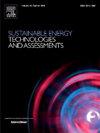Exploring synergy between solar pumping and nitrogenous fertilizer requirement in India
IF 7.1
2区 工程技术
Q1 ENERGY & FUELS
Sustainable Energy Technologies and Assessments
Pub Date : 2025-01-01
DOI:10.1016/j.seta.2024.104126
引用次数: 0
Abstract
The sustenance of increasing population and climate change obligation have drifted the research towards integrating renewable energy with farming practices. The present study aims to understand the synergy between energy requirements of solar pumping and N-fertilizer in Indian conditions and presenting a techno-enviro-economic benchmark for producing sustainable nitrogenous fertilizer using unused energy from solar pumping at the farm level. Five major crops and their land shares have been identified for each agro-climatic zone, followed by the estimation of irrigation and N-fertilizer requirements, and sizing of solar pumping. The analysis using the surplus energy from solar pumping and N-fertilizer requirement suggests a required yield and rate of 0.126 kg N/kWh and 0.086 kg N/h for meeting 75 percent of the total requirement. A correlation between potential reduction in CO2 emissions, carbon tax, and cost, in terms of ammonia, the crucial reagent of N-fertilizers, estimates a benchmark cost of 0.768 USD/kg NH3 at a target emission of 0.5 kg CO2 eq./kg N. Integrating solar pumping with decentralized N-fertilizer production technology at the farm level can be effectively realized to cater to the irrigation and N-fertilizer requirements using solar energy and contribute to the fields of solar energy, agriculture, and sustainable development.

求助全文
约1分钟内获得全文
求助全文
来源期刊

Sustainable Energy Technologies and Assessments
Energy-Renewable Energy, Sustainability and the Environment
CiteScore
12.70
自引率
12.50%
发文量
1091
期刊介绍:
Encouraging a transition to a sustainable energy future is imperative for our world. Technologies that enable this shift in various sectors like transportation, heating, and power systems are of utmost importance. Sustainable Energy Technologies and Assessments welcomes papers focusing on a range of aspects and levels of technological advancements in energy generation and utilization. The aim is to reduce the negative environmental impact associated with energy production and consumption, spanning from laboratory experiments to real-world applications in the commercial sector.
 求助内容:
求助内容: 应助结果提醒方式:
应助结果提醒方式:


